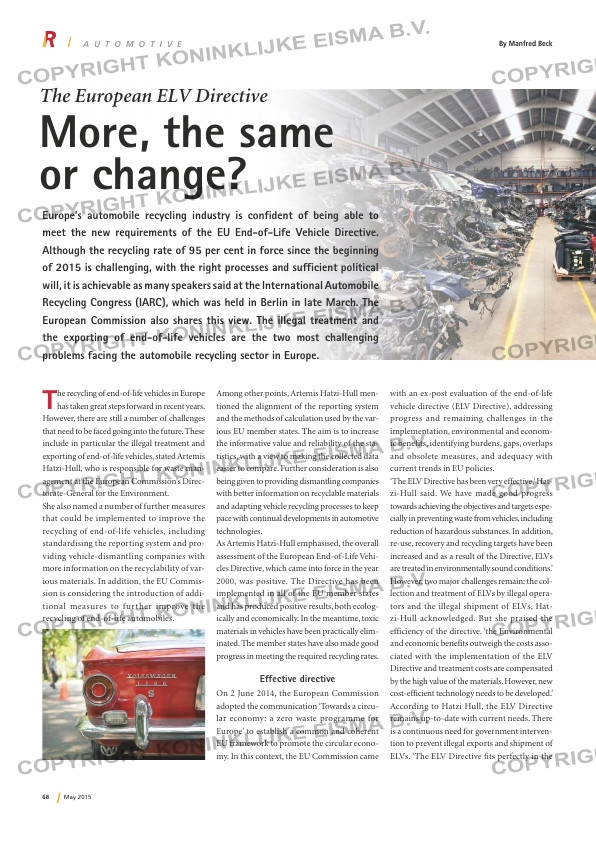Page 68 from: May 2015

68 May 2015
The recycling of end-of-life vehicles in Europe has taken great steps forward in recent years.
However, there are still a number of challenges
that need to be faced going into the future. These
include in particular the illegal treatment and
exporting of end-of-life vehicles, stated Artemis
Hatzi-Hull, who is responsible for waste man-
agement at the European Commission’s Direc-
torate-General for the Environment.
She also named a number of further measures
that could be implemented to improve the
recycling of end-of-life vehicles, including
standardising the reporting system and pro-
viding vehicle-dismantling companies with
more information on the recyclability of var-
ious materials. In addition, the EU Commis-
sion is considering the introduction of addi-
tional measures to further improve the
recycling of end-of-life automobiles.
Among other points, Artemis Hatzi-Hull men-
tioned the alignment of the reporting system
and the methods of calculation used by the var-
ious EU member states. The aim is to increase
the informative value and reliability of the sta-
tistics, with a view to making the collected data
easier to compare. Further consideration is also
being given to providing dismantling companies
with better information on recyclable materials
and adapting vehicle recycling processes to keep
pace with continual developments in automotive
technologies.
As Artemis Hatzi-Hull emphasised, the overall
assessment of the European End-of-Life Vehi-
cles Directive, which came into force in the year
2000, was positive. The Directive has been
implemented in all of the EU member states
and has produced positive results, both ecolog-
ically and economically. In the meantime, toxic
materials in vehicles have been practically elim-
inated. The member states have also made good
progress in meeting the required recycling rates.
Effective directive
On 2 June 2014, the European Commission
adopted the communication ‘Towards a circu-
lar economy: a zero waste programme for
Europe’ to establish a common and coherent
EU framework to promote the circular econo-
my. In this context, the EU Commission came
with an ex-post evaluation of the end-of-life
vehicle directive (ELV Directive), addressing
progress and remaining challenges in the
implementation, environmental and econom-
ic benefits, identifying burdens, gaps, overlaps
and obsolete measures, and adequacy with
current trends in EU policies.
‘The ELV Directive has been very effective,’ Hat-
zi-Hull said. We have made good progress
towards achieving the objectives and targets espe-
cially in preventing waste from vehicles, including
reduction of hazardous substances. In addition,
re-use, recovery and recycling targets have been
increased and as a result of the Directive, ELVs
are treated in environmentally sound conditions.’
However, two major challenges remain: the col-
lection and treatment of ELVs by illegal opera-
tors and the illegal shipment of ELVs, Hat-
zi-Hull acknowledged. But she praised the
efficiency of the directive. ‘the Environmental
and economic benefits outweigh the costs asso-
ciated with the implementation of the ELV
Directive and treatment costs are compensated
by the high value of the materials. However, new
cost-efficient technology needs to be developed.’
According to Hatzi Hull, the ELV Directive
remains up-to-date with current needs. There
is a continuous need for government interven-
tion to prevent illegal exports and shipment of
ELVs. ‘The ELV Directive fits perfectly in the
A U T O M O T I V E By Manfred Beck
Europe’s automobile recycling industry is confident of being able to
meet the new requirements of the EU End-of-Life Vehicle Directive.
Although the recycling rate of 95 per cent in force since the beginning
of 2015 is challenging, with the right processes and sufficient political
will, it is achievable as many speakers said at the International Automobile
Recycling Congress (IARC), which was held in Berlin in late March. The
European Commission also shares this view. The illegal treatment and
the exporting of end-of-life vehicles are the two most challenging
problems facing the automobile recycling sector in Europe.
The European ELV Directive
More, the same
or change?
RI 4-IARC.indd 68 04-05-15 09:28



